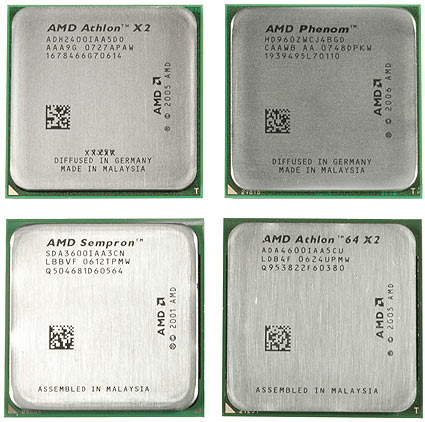AMD CPU Efficiency Compared
Power Consumption Then And Now: Time To Look At AMD
We published an interesting article last month: "Intel Power Consumption Then and Now" compared performance, power requirements and performance per watt of four different Intel processors. We started with an old Pentium 4 and went all the way up to a Core 2 Quad, and we ran all tests and benchmark at the same 3.0 GHz clock speed. The results were amazing, finding that current processors not only offer significantly more performance, but also much better energy efficiency than the old Pentium 4/D generation.
Of course we also wondered: shouldn't this also apply to AMD? Typically, we start any comparison alphabetically, which would have led us to analyze the performance per watt development of AMD first. Yet we found the Intel history more interesting at first, as the company went from one extreme to another, replacing the decrepit Pentium 4 battleship with its faster and much more efficient Core 2 cruisers. On the AMD side, there have also been significant developments in moving to 65 nm processors and to the Phenom quad cores, but these developments are evolutionary rather than revolutionary.
Another reason to look at the Intel processors first is their ease of comparison. It was simple to find a Pentium 4, Pentium D, Core 2 Duo and Core 2 Quad processor that we could compare on the same Socket 775 and at the same core clock speed. Although the bus speed and memory performance increased over time, all of these CPUs were or still are available at the same clock speed levels, so we picked 3.0 GHz for our comparison.
Looking at AMD's processors, it is more difficult to line up various models for a reliable comparison. On the one hand, we didn't have an Athlon 64 single core processor for Socket AM2. Switching to a Socket 939 motherboard would have required DDR400 memory instead of DDR2 RAM, which would have been acceptable, but the platform and chipset modification would have distorted comparability.
We used a Sempron processor to have at least some AMD64-based single core processor in the lineup. On the other hand, finding processors that run at the same core clock speed turned out to be an issue: while a clock speed decrease doesn't influence the SpeedStep feature on Intel processors, using a smaller multiplier turns off Cool'n'Quiet on AMD platforms. Since Cool'n'Quiet is an essential mechanism to minimize power consumption when there is little demand for high performance, we had to use our processor samples at their default clock speeds.
We did not want to run the AMD processors at too low a processor speed, to avoid jeopardizing the relevance of our results due to insufficient clock speed. Our best bet hence was 2.3 GHz, as there is the Phenom 9600, the Athlon X2 BE-2400 (which equals the Athlon 64 X2 4400+ 65 nm Brisbane, but is rated at 45 W instead of 65 W TDP). Since there was no 2.3 GHz processor in AMD's 90 nm generation, we added a 2.4 GHz Athlon 64 X2 4600+ (Windsor F2 core) and, not to forget, the Sempron 3600+. Unfortunately, this last model only runs at 2.0 GHz, but we did not have a faster model at the time we performed our testing. Consider the slower Sempron to be there for your reference only...
A 100 MHz difference between the Athlon X2 BE-2400 Compare Prices on AMD Athlon X2 BE-2400 and the Athlon 64 X2 4600+ is small enough to have little impact on the overall results. What mattered to us was to expose the advances AMD made when switching from one product generation to the next. Let's look at how AMD's performance and performance per watt ratio improved over time. We'll start with the single core 90 nm Sempron, look at the dual core 90 nm Athlon 64 X2, continue with the dual core 65 nm Athlon X2, and conclude with AMD's latest product, the 65 nm Phenom quad core processor.
Get Tom's Hardware's best news and in-depth reviews, straight to your inbox.
Current page: Power Consumption Then And Now: Time To Look At AMD
Next Page Processors
Patrick Schmid was the editor-in-chief for Tom's Hardware from 2005 to 2006. He wrote numerous articles on a wide range of hardware topics, including storage, CPUs, and system builds.
